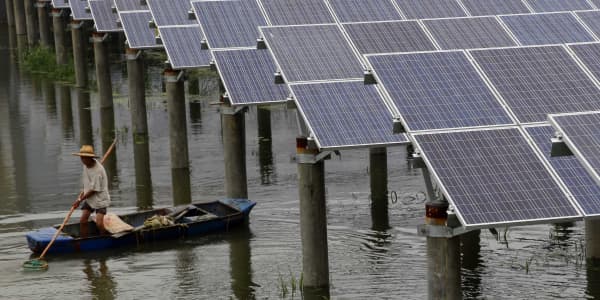Across Asia, countries are working to meet growing demand for electricity, with many targeting renewables amid growing concerns about pollution and over-reliance on fossil fuels. The region needs around $700 billion in energy investment through 2035, according to International Energy Agency estimates -- a demand that's made Asia the world leader in adding renewable energy capacity.
These are the most impressive renewable energy projects in Asia.
By CNBC's Leslie Shaffer
Posted 13 July 2015
Japan turns to offshore wind
Japan's Fukushima province was hard hit by the earthquake, tsunami and resulting nuclear disaster in 2011. The region now is home to an offshore wind farm demonstration project that aims to install three floating wind turbines, with an estimated around 18.8 billion yen investment, funded by the country's Ministry of Economy, Trade and Industry (METI).
When the project is completed, it's likely to become the world's largest floating offshore wind farm.
Indonesia pursues geothermal
Faced with chronic power shortages, Indonesia is pursuing geothermal projects. Those projects often struggle to find financing as they require a lot of upfront capital spending and investors consider them risky. But the country has the largest geothermal resources in the world.
Indonesia is beginning work on the Sarulla geothermal project on Sumatra island, likely the largest of its kind, after managing to secure around $1.2 billion in financing from multiple sources, with construction starting around 25 years after planning began. The project is expected to have around 330 megawatts (MW) of capacity.
South Korea "recycles" a solar site
After spending 30 years as a quarry, Geogeum Island in South Korea has been repurposed as a 25MW solar energy park spread over 660,000 square meters. The area is South Korea's sunniest.
The country has a history of seeking innovative places for its solar panels, including using them to as "shade" over bike paths.
Solar goes swimming?
The world's largest floating solar farm is at Sakasamaike Pond in Japan's Kasai, Hyogo Prefecture. The 2.3MW plant has around 9,000 panels spread over floats and can produce enough electricity for around 820 households.
One of the advantages of floating solar plants is that the water helps to keep the panels from heating up, improving the efficiency. Japan has shown particular interest in the format due to its large number of reservoirs to supply water for growing rice; the panels can also help to prevent outbreaks of blue-green algae by blocking the light from reaching the water surface.
India harnesses the sun
The Welspun Energy solar farm in India's Madhya Pradesh state is one of the world's largest, generating 151MW. That's expected to supply around 720,000 households with electricity, the company said.
India, the third-largest emitter of greenhouse gasses, has been targeting an increase in renewable energy production, with a goal of boosting its solar energy capacity to 100GW by 2022.
Not all renewable projects go as planned
China's Three Gorges Dam hydropower project has been controversial pretty much from the get-go.
At least 1.4 million people were relocated, both in the construction phase and later, after rising water levels caused unforeseen landslides. Critics say the massive structure and the weight of the water in its 600-kilometer-long reservoir have caused thousands of "slight" earthquakes. It's also wrought havoc on the ecosystem along the Yangtze River and resulted in the flooding of many archeological sites. The reservoir also has collected tons of garbage and contamination after flooding toxic sites.
Estimates of the cost vary widely, but in 2009, the official Xinhua news agency reported the price tag at around $37 billion, including the cost of relocating displaced people. But the project has met its goal of producing renewable energy, producing more than 200 billion KWH in 2014, estimated at more than twice the electricity demand of Beijing.





